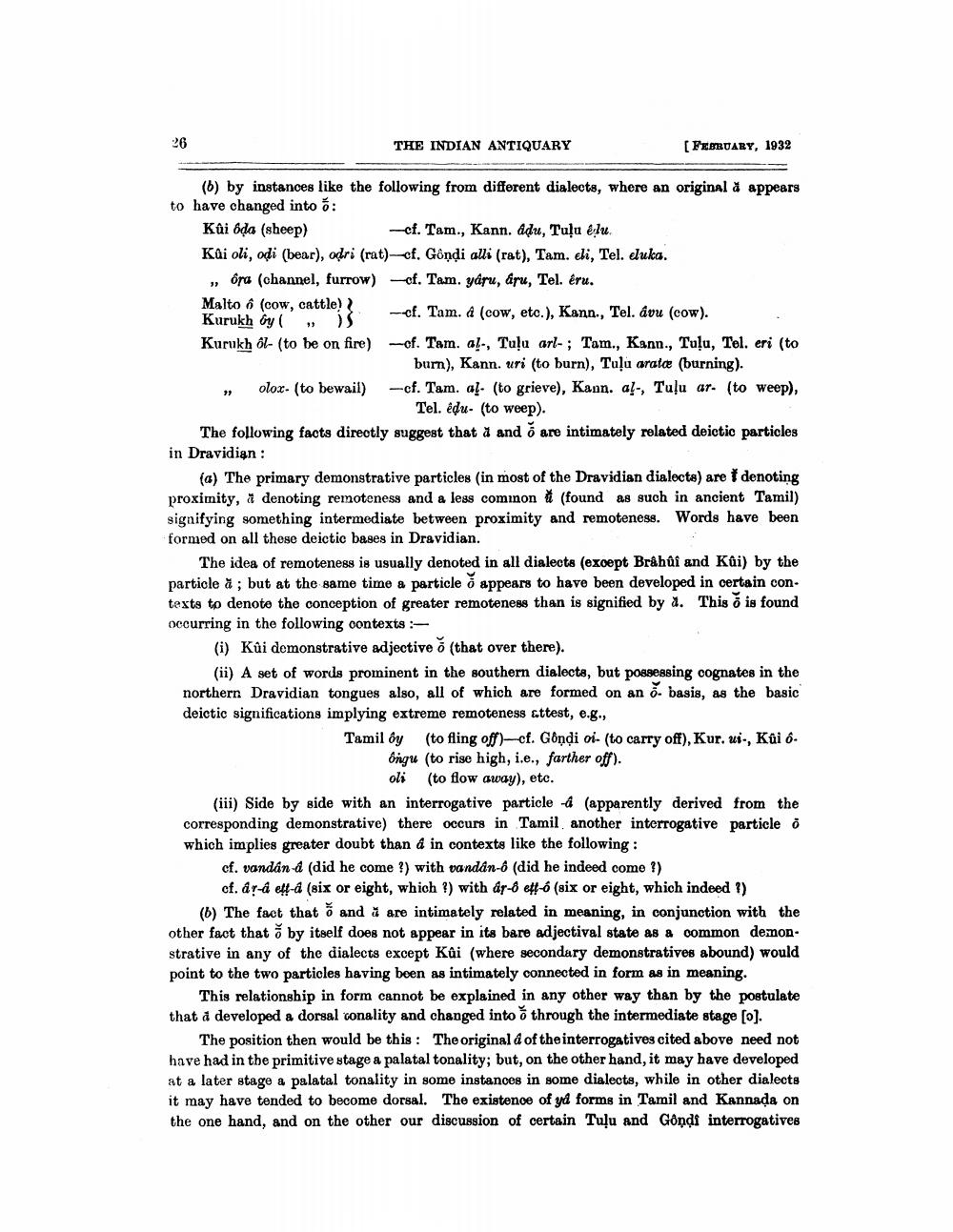________________
THE INDIAN ANTIQUARY
(FEBRUARY, 1932
(6) by instances like the following from different dialects, where an original à appears to have changed into o: Kûi ôda (sheep)
-cf. Tam., Kann. adu, Tulu élu. Kui oli, odi (bear), odri (rat)--cf. Gôndi alli (rat), Tam. eli, Tel. eluka.
, Ora (channel, furrow) - cf. Tam, ydru, dru, Tel. éru. Malto 6 (cow, cattle! -. Tam. (cow, etc.), Kann., Tel. dvu (cow). Kurukh oy ( ) Kurukh ôl- (to be on fire) -of. Tam. al., Tuļu arl- ; Tam., Kann., Tulu, Tel. eri (to
burn), Kann. uri (to burn), Tuļu aratce (burning). oloc- (to bewail) -cf. Tam. a!. (to grieve), Kann. a!-, Tuļu ar. (to weep),
Tel. édu- (to weep). The following facts directly suggest that a and o are intimately related deictic particles in Dravidian :
(a) The primary demonstrative particles in most of the Dravidian dialects) are † denoting proximity, a denoting remoteness and a less cominon (found as such in ancient Tamil) signifying something intermediate between proximity and remoteness. Words have been formed on all those deictic bases in Dravidian.
The idea of remoteness is usually denoted in all dialects (except Brahûi and Kũi) by the particle a ; but at the same time a particle o appears to have been developed in certain con. texts to denote the conception of greater remoteness than is signified by a. This is found occurring in the following contexts -
(i) Küi demonstrative adjective o (that over there).
(ii) A set of words prominent in the southern dialects, but possessing cognates in the northern Dravidian tongues also, all of which are formed on an o- basis, as the basic deictic significations implying extreme remoteness attest, e.g.,
Tamil ôy (to fling off)--cf. Gondi oi- (to carry off), Kur. ui., Küi 6.
ôngu (to rise high, i.e., farther off).
oli (to flow away), etc. (iii) Side by side with an interrogative particle & (apparently derived from the corresponding demonstrative) there occurs in Tamil another interrogative particle o which implies greater doubt than a in contexts like the following:
cf. vandán -a (did he come ?) with vandan-6 (did he indeed come ?)
cf. dra eff-a (six or eight, which ?) with ár-8 et 6 (six or eight, which indeed ?)
(6) The fact that o and are intimately related in meaning, in conjunction with the other fact that ở by itself does not appear in its bare adjectival state as a common demonstrative in any of the dialects except Kûi (where secondary demonstratives abound) would point to the two particles having been as intimately connected in form as in meaning.
This relationship in form cannot be explained in any other way than by the postulate that a developed a dorsal conality and changed into o through the intermediate stage (o).
The position then would be this: The original d of the interrogatives cited above need not have had in the primitive stage a palatal tonality; but, on the other hand, it may have developed at a later stage a palatal tonality in some instances in some dialects, while in other dialects it may have tended to become dorsal. The existence of yd forms in Tamil and Kannada on the one hand, and on the other our discussion of certain Tuļu and Gôndi interrogatives




